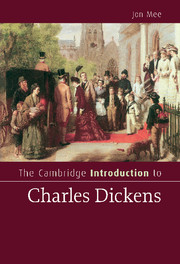Book contents
- Frontmatter
- Contents
- List of illustrations
- Preface
- Chronology
- List of abbreviations
- 1 Dickens the entertainer: ‘People must be amuthed’
- 2 Dickens and language: ‘What I meantersay’
- 3 Dickens and the city: ‘Animate London … inanimate London’
- 4 Dickens, gender, and domesticity: ‘Be it ever … so ghastly … there's no place like it’
- 5 Adapting Dickens: ‘He do the police in different voices’
- Afterword: Dickens's world
- Notes
- Further reading
- Index
- Cambridge Introductions to …
4 - Dickens, gender, and domesticity: ‘Be it ever … so ghastly … there's no place like it’
Published online by Cambridge University Press: 05 August 2012
- Frontmatter
- Contents
- List of illustrations
- Preface
- Chronology
- List of abbreviations
- 1 Dickens the entertainer: ‘People must be amuthed’
- 2 Dickens and language: ‘What I meantersay’
- 3 Dickens and the city: ‘Animate London … inanimate London’
- 4 Dickens, gender, and domesticity: ‘Be it ever … so ghastly … there's no place like it’
- 5 Adapting Dickens: ‘He do the police in different voices’
- Afterword: Dickens's world
- Notes
- Further reading
- Index
- Cambridge Introductions to …
Summary
The idyllic group of those who survive in Our Mutual Friend is very much conceived of as a domestic circle. Bella's right to her position as the wife of John Rokesmith and then, more properly, John Harmon, is signalled in her command of the Complete British Family Housewife (OMF 4: 5, 666). The snug group of the family seems to offer the only shelter from the external world and its forces in most of the novels Dickens wrote. Those pressures are most often constituted in terms of the grinding alienation and degradation of London, the Victorian world city. In Barnaby Rudge and then A Tale of Two Cities, the only two historical novels he wrote, the domestic circle seems the best refuge against the impersonal forces of change in history. Dickens had an important role in creating the idea of the sanctity of the family for the nineteenth century and beyond, not least in the domestic gathering at Christmas. In the novels, however, the family is scarcely ever a stable institution, especially at the outset of the plots, but even those groups who survive and prosper are not usually naturalized into happy clusters. Bella, after all, turns out to have married and made herself happy with the ‘wrong’ man, who turns out to be the ‘right’ man for whom she was originally intended as part of his inheritance, ‘willed away’, as she puts it, ‘like a horse, or a dog, or a bird’ (OMF 2: 13, 371).
- Type
- Chapter
- Information
- The Cambridge Introduction to Charles Dickens , pp. 64 - 83Publisher: Cambridge University PressPrint publication year: 2010



